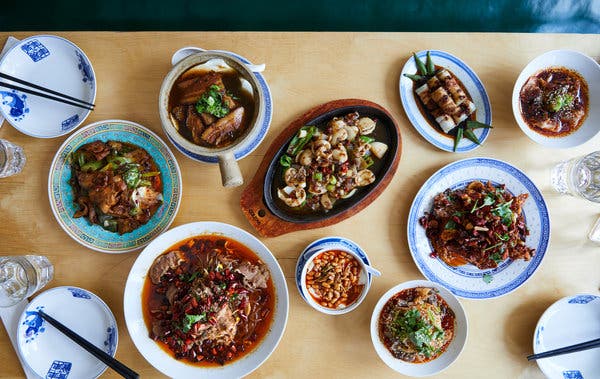At Birds of a Feather in Williamsburg, Brooklyn, a bowl of slippery, feather-light pork won tons in chile oil has a red ring suspended around its edge that, to the spice-averse, may look like a warning. But the heat arrives gently, the oil used sparingly in a special sauce that’s more sweet and tangy than it is fiery. The chef, Ziqiang Lu, sprinkles the dish with a confetti of stir-fried dried chiles ground together with rattan peppercorns, a type of green Sichuan peppercorn so floral that it smells as if it’s in the process of blooming.
“I want people to understand Sichuan cuisine better, and not just get hung up on the hot aspect of it,” Mr. Lu said through a translator. “It’s very varied, and there’s a big spectrum of how the spices should interact.”

Mr. Lu, 54, who is from Chengdu, brings the same zeal to his more subtle dishes as he does to his fiery-funky dan dan noodles, which are some of the city’s best. Walking through the dining room — a long, tall space that used to be a hair salon — you may breathe in a thick cloud of pungent, peppery smoke that will set off a small chorus of coughs.
The plume comes from a patch of raw onions thrown into a hot dry skillet to soften and sear before being joined by a bowl of squid cooked in chicken stock with XO sauce, dried scallops and small, sweet-spicy peppers. The servers preparing the dish tableside then cover the skillet, letting everything steam together as the liquid further softens the dried scallops until they taste like candy from the sea. The result is delicately briny, the only spice coming, quietly, from those peppers, more fragrant than bold.
The husband-and-wife team who opened Birds of a Feather in 2017, Xian Zhang and Yiming Wang, hired Mr. Lu in part because of his classical training in Chinese cuisine and his desire to experiment. “That combination is rare,” Ms. Wang said. Their first restaurant was Cafe China, in Midtown, which also serves Sichuan food; there, they’ve found it more challenging to experiment, as the restaurant has become popular with business people and Chinese tourists looking for familiar Sichuan mainstays.
In Brooklyn, the owners could take more chances, and they appreciated that Mr. Lu — who was the chef at Cafe China from 2010 to 2011 — was willing. It shows in the pork and okra rolls, the chef’s reimagining of a more traditional dish of pork belly served over sliced cucumber. Each layer — the pork, the gently poached okra and its viscous innards — offers its own interpretation of softness, the whole thing more thrilling in its refusal to provide much in the way of contrasting crunch. The rolls come stacked neatly, with long slices of okra fanned out at the sides like little crab legs: every time I see the plate, I imagine a chef arranging each leg with a small chuckle.
With a larger kitchen, Mr. Lu was able to spread out a bit and take on projects that were previously unavailable to him at Cafe China. Here, he makes his own soy milk — a barely sweet, nutty antidote to those times when the spice reaches a higher decibel — and his own tofu pudding, which he serves as a savory appetizer mixed with chile oil and fried soybeans. And dim sum, which was his specialty as a cook in Chengdu, gets a luxurious amount of attention here: He hand-makes wrappers for his pork won tons and all of his dumplings, like the wrinkly sticky-rice, ham and mushroom-filled shumai.
That dedication to small details carries through to the dessert menu. Mr. Lu ferments his own rice for the rice-wine soup with rice balls, sweet and earthy little jewels made from glutinous rice flour and filled with black sesame paste. Czi ba, balls of sticky rice, come with a light dusting of soybean powder.
At many restaurants in China, this dessert is turned into theater: Mr. Lu took great pleasure in acting out the ways they would throw the rice balls into a bowl of rice powder in clear view of the dining room. Here, he goes the less messy route — simply dusting the balls with the powder — but the result is just as thrilling.
Follow NYT Food on Twitter and NYT Cooking on Instagram, Facebook, YouTube and Pinterest. Get regular updates from NYT Cooking, with recipe suggestions, cooking tips and shopping advice.




